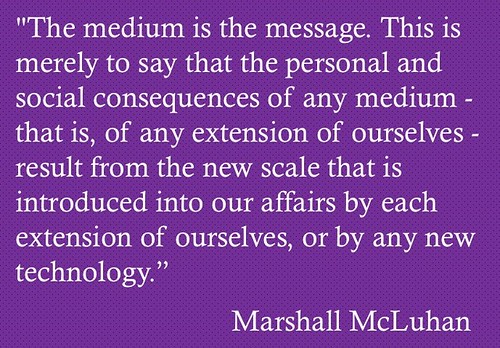
Below is statement (adapted slightly from its original purpose) of some of my views on how Extension should be approaching marketing, communications, and educational efforts. In the spirit of transparency, I am sharing these thoughts and would love to hear from you on these concepts and other ways that we can do a better job of convening education, communications, and marketing in Cooperative Extension.
The flattening of the information flow indicates that communications and marketing methods should take advantage of the knowledge and appreciation of others and engage them. Also online and offline behaviors are becoming less separate. We already see this convergence in those who have never known life without the Internet. Today’s youth do not have separate online and offline lives—they have one life—a concept that most adults have trouble understanding, yet our future depends on our understanding these changes.
While we know that those who use Cooperative Extension are very satisfied with Cooperative Extension, we are not widely known to the public (2008 Copernicus Survey). Only 15% of the U.S. citizens between the ages of 18 and 35 have heard of Cooperative Extension, and only 27% of the US adult population knows who we are. A dismal 5% of the younger adults have used Cooperative Extension and 11% of the US adult population has used Cooperative Extension. These findings indicate that we need to do a better job branding Cooperative Extension. Part of the strategy is to blend our educational and marketing efforts—organizationally and individually. Faculty, agents, and staff who represent Extension everyday are our best resource (haven't we said this for decades?) and the best way to develop and deepen our credibility by working differently.Some elements of a converged educational and marketing effort:
Some concepts and traditional approaches to education and marketing should continue to be the basis of our work, however Extension needs to find ways to reach and scale the effectiveness of our programs and meeting new expectations of the public. This different way of working includes communications, marketing and educational efforts that are merged and building relationships with people who don’t come to our meetings or into our local offices.
Working differently to connect with others includes being open and transparent, learning and sharing simultaneously, and embracing co-learning and contributions outside of land-grant universities. Interestingly, these values are not different from the early days of Cooperative Extension with on-farm research and in-home demonstrations. Today though, we have the ability to scale and spread the interaction and engagement in new ways.
While we want to continue to use some traditional marketing efforts, occasionally we need to jolt audiences or potential audiences with unique and disrupting messaging. Cooperative Extension generally does not want to upset (for good reasons) our existing clientele—clientele who are often like ourselves. Sometimes we have to test the system in order to make progress with clientele who we are not currently reaching by using disruptive messages in education, communications, and marketing. This approach may come with risks but has the opportunity to reach new audiences. These decisions should be considered and weighed.
- Start with a mindset that marketing is not a separate function than the educational function and that these efforts are everyone's responsibilities--not just those in the communications and marketing units.
- Make a habit of listening (like any good marketing plan)--listening in communities we are not active in and in communities where we already have relationships.
- Think of building online relationshps like we think of building relationships locally.
- Think about how to share while we are learning. We don't have to wait until published results are available to start discussing what we already know.
- Develop a plan of work but make sure there is room to adjust. Opportunities may come about in unexpected ways.
- Plan and develop strategies and tactics for communications, and most importantly, engagement, but be flexible to seek new ways and discard ways that don't work.
- Know that community building and participation are works in progress and will grow, but the growth may be more like a curving spiral and less like a line.
- May need to target certain connections and interests.
- Be ready to identify new connections because of serendipitous encounters and plan for serendipity.
- Evaluate based on goals and search for patterns of activities, evaluating each stage and change tactics along the way.
- Involve more than one person to keep organizational accounts up-to-date as staying consistent is difficult with only one person.
- Encourage individuals to establish and develop their online reputations.
- Understand social media is more than Facebook and Twitter and is more than the technology itself. Contributing in collaborative environments maybe the very best way to grow ourselves.
The process of "scaling" ourselves without growing our organization begins with understanding what the challenges, opportunities, and characteristics of the future.
"The medium is the message. This is merely to say that the personal and social consequences of any medium - that is, of any extension of ourselves - result from the new scale that is introduced into our affairs by each extension of ourselves, or by any new technology." Marshall McLuhan
"The medium is the message. This is merely to say that the personal and social consequences of any medium - that is, of any extension of ourselves - result from the new scale that is introduced into our affairs by each extension of ourselves, or by any new technology." Marshall McLuhan

McLuhan discoveries help us understand that failing to interpret how technologies shape us and how we shape technology means failure to be prepared for the the future.
Some of the ideas in this post came in part from some books I have read recently. I found these books particularly useful as we look at Cooperative Extension's future:
The Connected Company by Dave Gray and Thomas Vander Wal
The Race Against Machine by Erik Brynjolfsoon and Andrew McAfee
Where Good Ideas Come From by Steven Johnson
The photo is embedded from Flickr http://www.flickr.com/photos/67194724@N03/8357047751/